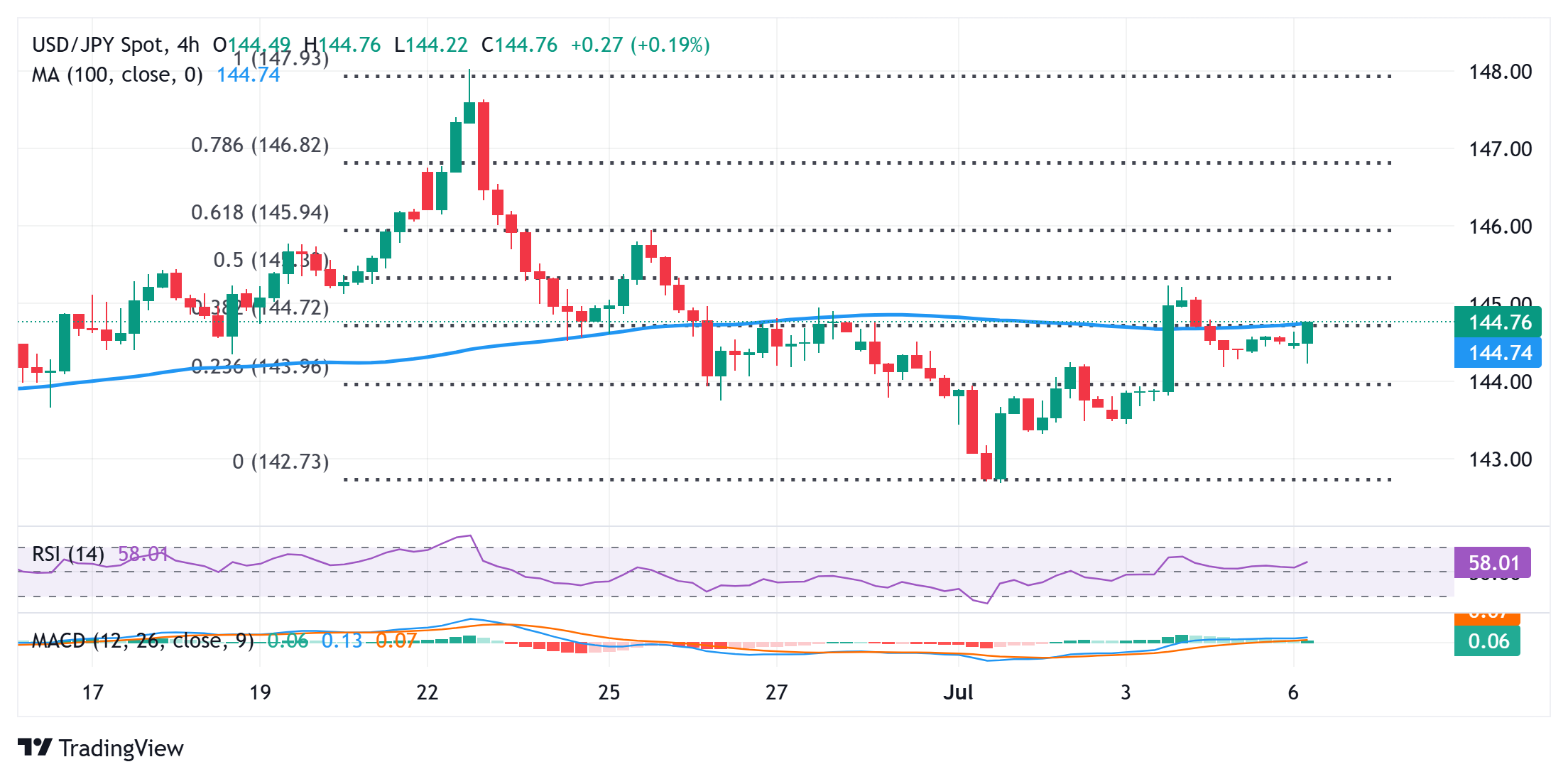- The Japanese Yen drifts lower in reaction to weaker domestic wage growth data.
- Geopolitical risks and divergent BoJ-Fed expectations should limit JPY losses.
- The USD bearish sentiment might further contribute to capping the USD/JPY pair.
The Japanese Yen (JPY) underperforms against a mildly positive US Dollar (USD) and assists the USD/JPY pair to attract fresh buyers during the Asian session on Monday. US President Donald Trump last week threatened more tariffs on Japan over its alleged unwillingness to buy American-grown rice. This could squeeze corporate profits and potentially undermine future wage growth, which, in turn, could complicate the Bank of Japan’s (BoJ) monetary policy normalization schedule and undermine the JPY.
Meanwhile, data released earlier today showed that real wages in Japan fell for the fifth straight month in May, at the fastest pace in nearly two years. This turns out to be another factor weighing on the JPY. Traders, however, seem convinced that the BoJ will hike interest rates again amid persistently higher domestic inflation. In contrast, the Federal Reserve (Fed) is expected to resume its rate-cutting cycle in the near future. This might cap the upside for the USD and lend support to the lower-yielding JPY.
Japanese Yen adds to weaker domestic data-led intraday losses
- The Israeli military carried out intense strikes on Houthi targets in three Yemeni ports and a power plant early this Monday in response to repeated attacks by the Iran-aligned group on Israel. This marks the first Israeli attack on Yemen in almost a month and should drive safe-haven flows towards the Japanese Yen.
- Government data released earlier today showed that Nominal Wages in Japan rose 1% in May 2025 from a year earlier, marking the third straight month of deceleration and falling well short of market expectations. This was also the weakest growth since March 2024 amid an 18.7% plunge in special bonus payments.
- Adding to this, inflation-adjusted real wages posted the steepest decline in 20 months and fell 2.9% YoY in May compared to a revised 2.0% drop in the previous month. Meanwhile, the consumer inflation rate that the labour ministry uses to calculate real wages climbed 4.0% YoY during the reported month.
- The data fueled concerns that stagnant real incomes could dampen consumer spending and stall broader economic recovery amid heightened uncertainty over US President Donald Trump’s new tariffs. This might complicate the Bank of Japan’s path to normalising interest rates and capping gains for the JPY.
- The US Dollar, on the other hand, struggles to register any meaningful recovery from a multi-year low touched last week amid relatively dovish Federal Reserve expectations. In fact, traders are pricing in over a 70% chance of a rate cut in September and at least two 25 basis points rate reductions this year.
- Investors now look forward to the release of the FOMC meeting minutes on Wednesday for fresh cues about the Fed’s policy outlook and rate-cut path. This, in turn, will play a key role in influencing the near-term USD price dynamics and providing some meaningful impetus to the USD/JPY pair.
USD/JPY now seems poised to surpass 145.00 and test 145.25-145.30 hurdle

Momentum beyond the 144.65-144.70 confluence – comprising the 100-period Simple Moving Average (SMA) on the 4-hour chart and the 38.2% Fibonacci retracement level of the June-July downfall – would be seen as a key trigger for the USD/JPY bulls. The subsequent move up could allow spot prices to reclaim the 145.00 psychological mark and test the 145.25-145.30 supply zone. A sustained strength beyond the latter should pave the way towards the 61.8% Fibo. retracement level, around the 146.00 round figure.
On the flip side, the Asian session low, around the 144.20 horizontal zone, could offer some support ahead of the 144.00 round figure, or the 23.6% Fibo. retracement level. A convincing break below might shift the bias back in favor of bearish traders and drag the USD/JPY pair to the 143.45 intermediate support en route to the 143.00 mark. The downward trajectory could extend further towards the 142.70-142.65 region, or a one-month low touched last Tuesday.
Bank of Japan FAQs
The Bank of Japan (BoJ) is the Japanese central bank, which sets monetary policy in the country. Its mandate is to issue banknotes and carry out currency and monetary control to ensure price stability, which means an inflation target of around 2%.
The Bank of Japan embarked in an ultra-loose monetary policy in 2013 in order to stimulate the economy and fuel inflation amid a low-inflationary environment. The bank’s policy is based on Quantitative and Qualitative Easing (QQE), or printing notes to buy assets such as government or corporate bonds to provide liquidity. In 2016, the bank doubled down on its strategy and further loosened policy by first introducing negative interest rates and then directly controlling the yield of its 10-year government bonds. In March 2024, the BoJ lifted interest rates, effectively retreating from the ultra-loose monetary policy stance.
The Bank’s massive stimulus caused the Yen to depreciate against its main currency peers. This process exacerbated in 2022 and 2023 due to an increasing policy divergence between the Bank of Japan and other main central banks, which opted to increase interest rates sharply to fight decades-high levels of inflation. The BoJ’s policy led to a widening differential with other currencies, dragging down the value of the Yen. This trend partly reversed in 2024, when the BoJ decided to abandon its ultra-loose policy stance.
A weaker Yen and the spike in global energy prices led to an increase in Japanese inflation, which exceeded the BoJ’s 2% target. The prospect of rising salaries in the country – a key element fuelling inflation – also contributed to the move.

